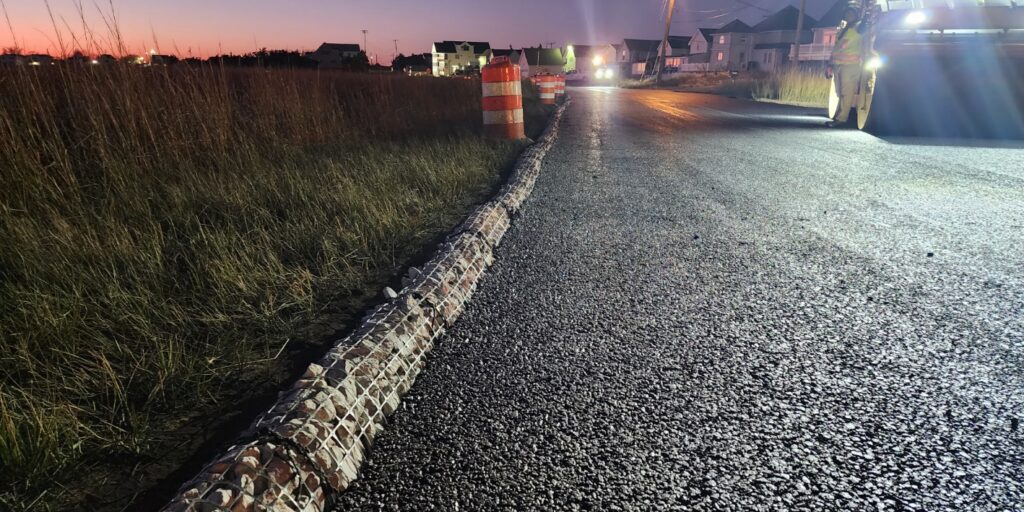Adding resilience to roads without reconstruction
In Vermont this summer, torrential rains caused flooding of historic proportions, washing out roads or covering them in feet of mud. And in some coastal areas, sea level rise is making ‘sunny-day’ flooding a twice-monthly occurrence when the moon’s cycles pull tides higher. Often, the hardest hit areas during such extreme weather events are communities’ secondary roadways, which provide vital last-mile access to businesses and residents as well as critical day-to-day connections at the local level. Those communities now face the challenge of adding resilience to their transportation systems—not to prevent flooding from happening, but to ensure their roads are still usable after waters recede.
Cost is, of course, a major hurdle in the way of this goal. When it comes to roadway infrastructure spending, it’s often primary roads that get the attention and federal dollars. As a result, complete reconstruction to build in needed resilience can be prohibitively expensive for the states, counties and local authorities footing the bill. Fortunately, road managers have more affordable—and less disruptive—options involving improved planning and new technology approaches that can help protect secondary roads from extensive damage even in the face of growing climate threats.
Resilience as a spectrum
For Amir Golalipour, P.E., infrastructure resilience research program manager with the Federal Highway Administration, the spectrum of options begins with what might be called “watchful waiting.” Identifying and monitoring areas that could be vulnerable to events like mudslides or flooding is a good starting point, giving highway departments a chance to put response measures in place so recovery can happen more quickly and efficiently.
“You don’t always have to do an action, your action could just be monitoring—you do your analysis and have it on your radar,” he says. “And if suddenly you know a scale four or five hurricane is going to hit, you have a contract mechanism in place and know what you need to do to repair that road. If you already have considered different options when that extreme event happens, you can respond to it quickly and recover rapidly.”
Of course, the analysis Golalipour describes needs to be fairly granular, according to Jo Sias, a civil and environmental engineering professor at the University of New Hampshire (UNH) and leader of the school’s Center for Infrastructure Resilience to Climate (CIRC). Obviously, a road can travel through multiple environments, so understanding the risks any particular stretch faces can be important to supporting its overall resilience.
“So, with coastal roadways, when you’ve got rising sea levels, that translates to rising groundwater tables, but it’s not just at the coast,” she says, citing just one example. “Depending on the geology, it can be several kilometers inland.”
CIRC is one of several research groups working on strategies that state-level departments of transportation can use to evaluate coastal roadway adaptation options. “It includes groundwater rise. It includes surface inundation. It includes wave action and washout.” Existing conditions, along with methods utilizing both hard and soft infrastructure, can be used to provide protection. “It’s not just about rebuilding—you’ve got an existing pavement, so how do you adapt?”
As an example, Sias cites a current CIRC project with the National Oceanic and Atmospheric Administration (NOAA) focusing on a New Hampshire road that, in just a half-mile’s distance, includes oceanside, harborside and marsh-side sections. Each of these locations may need to be addressed separately and require their own individual solutions, she says.
“If there’s a vulnerable section, and there are alternative routes, you just let it go,” she says. This is performed by creating regular detours for high-water periods, or where suitable, permanent alternatives exist, simply abandoning the road. “If you are going to adapt, there are also simple things you can do, like raising the roadway, which is not totally reconstructing it. And it might be enough to enhance the salt marsh or build the dunes a little bit higher. It’s being able to look at more of a holistic view of the entire area and system. That is really the direction that we need to be going.”
Using old tools in new ways
Permeable—also called porous—pavement can fall into this category of creative options for adding resilience to existing roads without going through the time and expense to completely rebuild them from the sublayer, up. Ben Bowers, P.E., assistant professor of civil engineering at Auburn University, recently consulted with Jim Pappas, director of transportation, resiliency and sustainability with the Delaware Department of Transportation (DelDOT) on a project incorporating permeable asphalt. DelDOT was looking for options to address sunny-day flooding that had become a twice-daily occurrence with every high tide for a road that was a small community’s only route to area schools and shopping.
“We thought, what if we built a porous pavement layer on top of the existing road, because the existing road is fine, it’s just that it’s underwater and the cost to elevate it is so expensive,” Bowers says. “Just build a porous pavement and then line it. Use traditional storm water techniques that you would use on a construction site to make sure you don’t have sediment moving. Take that aggregate and wrap it in a fabric.”
As Pappas notes, there was urgency to address the flooding.
“We didn’t have time to study this for five or 10 years—these people plan their days around the tide cycles,” he says. “That has pushed us to come up with quick, somewhat innovate things.”
The team’s move to permeable asphalt instead of conventional, dense, graded hot-mix pavement helped address two issues, Pappas says, beginning with providing a lower-weight alternative. “These areas are saturated all the time, so we were concerned about the unit weight – paving material that weighs 150 pounds per cubic foot is going to settle—so, we spend all this money and in six months or a year, it disappears into the marsh.”
And then, of course, there’s the water-management issue, Pappas adds. “We’re literally using the pavement as a reservoir,” he says. “The water will flow through the pavement, because what we have is water on both sides of the road.”
A second innovative addition is the use of geogrid to wrap aggregate into bundles, thereby creating permeable shoulders on either side of the road. Geogrid is often used to improve stability and uniformity in roadway aggregate layers. In this application, though, it’s serving two different purposes.
“One is, it’s acting as a filtering system, because we know with pervious pavements, they clog, and our maintenance people are not going to vacuum or sweep that location,” Pappas says. “And the other thing it does is it prevents a drop-off—we ended up putting on five inches of pavement and we can’t have a five-inch drop on the edge. So, if somebody kind of goes off the road, they’re not going to plop right down into the marsh.”
The design was a first for DelDOT, which might otherwise have required the road to be raised a full two feet to keep it above flood level. That approach would have triggered significant permitting and related environmental studies. A similar plan using permeable pavement is now being implemented for a second Delaware community. In both cases, Bowers notes, the design team took a second look at materials they were already familiar with to see how they could be used in a new way – not necessarily to solve the flooding problem, but to reduce its impact to a manageable level.
“At the end of the day, you don’t have to reinvent the wheel, just use the specs you have differently,” he says. “And that’s kind of the resilience thinking we’re talking about, where you can take existing tools and apply them differently to make the system more resilient.”
Paul Schmitz is market manager of public roads for Tensar Corporation, a civil engineering company.




















